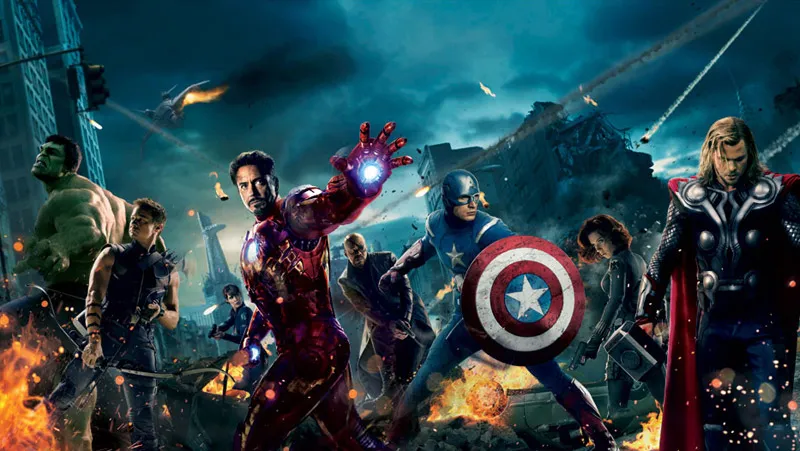I’ve written before about movie scores and how teenage me spent hours laying on the couch with my Walkman, zoning out to Star Wars and obsessing about the individual themes and how they all fit together. This time, I’m getting a little more specific. Heroic themes—the subject can be a little bit (or a lot) subjective. I mean, if you think the “hero/heroine/protagonist” of a given title is someone other than the main character—for example, if you are yourself of a villainous nature and consider Voldemort the misunderstood hero of the Harry Potter franchise, then… we might not agree on some things.
What makes a hero theme? They’re not all triumphant, blaring horns. A good hero theme (well, ANY good theme) actually uses the instruments, meter, and orchestration to mirror the character’s (or group or place’s) nature via music. Think about it—Darth Vader’s big, villainous Imperial March is actually perfect for a messed-up guy in a big suit, whose ego has been inflated to maniacal levels. It sounds full of its own importance, which is exactly what led Anakin down the dark path he chose in the first place. What angsty teen who lost their hotness (pun intended) in a lava pit wouldn’t fantasize about being the biggest bad in the room? But enough of villains for now—even if Anakin’s status as a clear villain or hero is a bit murky.
Often, a heroic theme is associated with a main protagonist, but just as as often, a heroic theme represents a group of people, a place, or even a particular iconic battle. Howard Shore’s Lord of the Rings soundtracks make excellent use of this—his themes are as often assigned to places and objects as they are to individuals.
A useful dichotomy to understand when thinking about heroic themes is the Batman/Superman dynamic. There is a certain darkness vs. light thing going on with the two most popular DC characters, and that difference is evident in the choice of composers and tone of music chosen to represent each hero. Batman’s theme, as written by Danny Elfman, sounds like vigilante justice that will find you in the back alley, shake you down for information, and ask if you killed its parents. Superman’s theme, written by John Williams, sounds like fighting the good fight because it’s the right thing to do. And also like flying. A lot like flying. Each theme suits the hero in question, and, I think, provides a good example of what it sounds like when the complexities involved in scoring a character appropriately are addressed. I’ve categorized some of my personal favorite heroic themes into: Individual Protagonists, Heroic Ensembles, and Place/Era.
Individual Protagonists:
1.) Indiana Jones – The main theme from the Indiana Jones movies is, I believe, technically called “The Raiders March,” but pretty much everyone recognizes it as the Indiana Jones theme. Never before and never since has a theme suited the protagonist more than John Williams’ Raiders March suited Indiana Jones. Not only does the theme evoke a sense of adventure, it also has an expansiveness to it that lends itself to serial adventure. Each of Indy’s adventures takes place in a different year, and time marches on, but so too does Indiana Jones, always game for a new adventure (and to kick some Nazis in their Nazi-faces.)
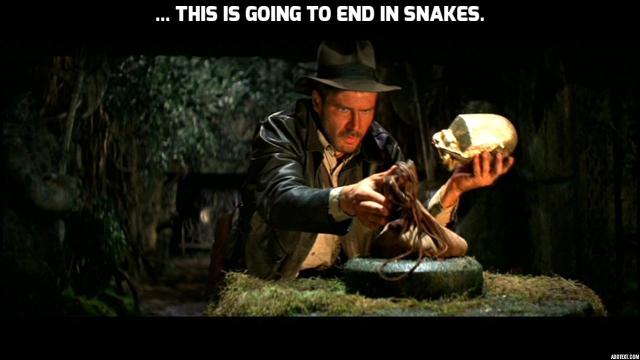
Why did it have to be snakes?
2.) Willow – The Main Theme from the movie Willow starts out fast-paced, calling to mind the heroic journey of Willow Ufgood as he protects the infant princess Elora Danan from the evil Bavmorda. Willow is not a stereotypical hero—he is a Nelwyn, a peaceful forest-and-meadow dwelling people similar to Hobbits in the Lord of the Rings Universe. Like the Hobbits of Tolkien (Bilbo, Frodo, Merry, Pippin, and Sam, anyway), Willow has an adventurous side that finds him volunteering to undertake a dangerous mission.
The Main Theme has its fast introduction, but soon turns to a slower, “love theme” that represents the gentle side of Willow—he is a devoted husband and father, and he volunteered to take the mission because a child was in danger, and the presence of said child threatened the safety of his own. I’m getting the feels, here! Willow is one of my favorite movie heroes—a family man with a brave spirit who learns as he goes. That Willow’s theme represents both aspects of his personality reminds me a lot of how Howard Shore used the gentle Shire theme, “Concerning Hobbits,” in various places throughout the movies, sometimes played softly and other times intermingled with other themes and with battle fanfare when the Hobbit heroes were being particularly badass.
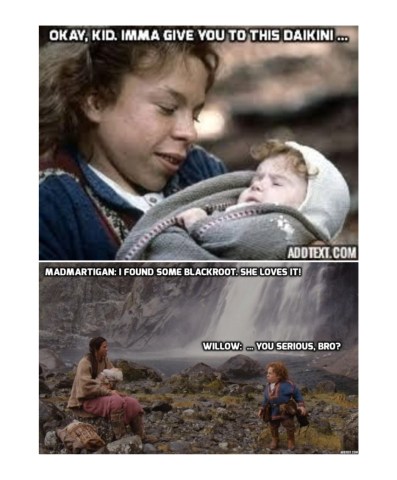
Geez, Madmartigan. Might as well give her some beer, right?
3.) Captain America – Alan Silvestri’s theme for Captain America is more than just a heroic fanfare of brass. Don’t get me wrong, it’s a magnificent, brassy, heroic fanfare. It’s glorious. As shining and glorious as Chris Evans’ chiseled features and as innocent and sincere as Steve Rogers, the Man Out of Time from a simpler era. At about the 20 second mark of the above linked track, the theme changes from triumphant brass and the atmospheric strings to a more purposeful march. I feel like this mirrors the transformation of Steve Rogers into Captain America in a pretty unique way.
Steve and Cap have the same heroic fanfare because Steve was heroic before his physical transformation. In other films, a character’s theme often changes from gentle to strong after they gain their powers/strength, etc. In Steve’s case, the potential for heroism was always there. When the “march” portion of the theme begins, it reminds the audience that this is a man driven by purpose and clear moral vision. Captain America is driven by a desire to defend and protect, to see good triumph over evil. Even when he finds himself in an unfamiliar world when he is awakened, the Captain marches on, steadfast in his devotion to helping the world become a better place. March on, Cap. And then save Bucky. And then you guys can hang out, have some pizza, and talk about old times. Right? Right? Do NOT screw with me, Marvel Cinematic Universe! I NEED them to be okay!
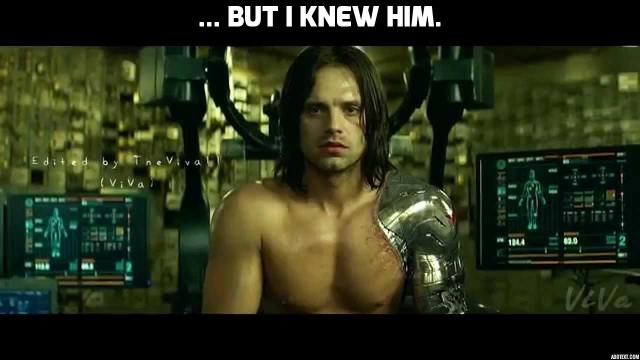
You just hang on, buddy. Steve’s going to rescue you!
4.) Pirates of the Caribbean – Heroism can be a murky business in the mean shipping lanes of the Caribbean. When politics and colonialism are all twisted up with magic, mystery, and, of course, treasure, sometimes up is down, dead is alive, pirates are heroes, and a woman can be a Pirate King. And that’s just a few of the things I love about the first three movies. The fourth one I haven’t seen. It had neither Will nor Elizabeth, and I couldn’t be bothered. The theme, “The Medallion Calls“, by Klaus Badelt and Hans Zimmer is my personal favorite from the franchise. I’ve written before about the fact that Jack Sparrow has two themes—this one and the “He’s a Pirate,” track, each one representative of different sides to Jack’s warring nature between hero or pirate.
I find the Medallion theme to be the more heroic of the two because it symbolizes Jack’s struggle against otherworldly powers, in which he is a clever hero in the trickster vein of such mythological characters as Odysseus. Parts of the theme reflect the circuitous nature of Jack’s internal logic—how he is able to talk himself (and others) into and out of things and rationalize his heroism as self-serving assholery and his piracy as heroism as it suits him in the moment. Jack knows how to navigate the waters of the weird—it’s when feelings and people become involved that things get difficult and lines get crossed. Ah, William. You poor, upstanding whelp.
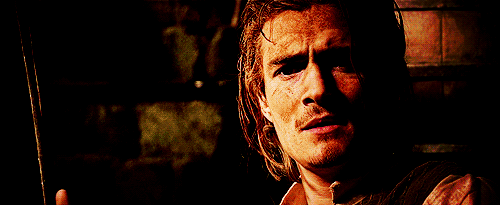
Will, remember when he said he was a pirate? That part was true.
5.) Xena: Warrior Princess – The Main Title from the TV show is sweeping and epic and fierce, just like the title character herself. Composer Joseph LoDuca used a traditional Bulgarian folk song called “Kaval sviri,” which, according to my extremely thorough research on Wikipedia, apparently means, “The Flute Plays.” There’s not much flute going on in the Xena theme song—more like the sounds of the kicking of asses and the taking of names, but also a sense of the scope of the world being wide and surrounded by the unknown. If you love the Xena theme as much as I do, you might enjoy this version of the original song, sung by a Bulgarian folk choir. I keep both versions on my “Fabulous Soundtracks” playlist on Spotify. The use of the women’s choir in the soundtrack version seems to have been inspired by the folk choir version, but more importantly, it sets up part of what Xena is all about—cool ladies being awesome.
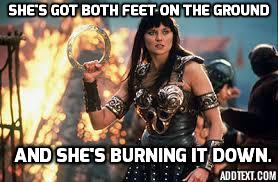
Thank you, Alicia Keys.
Heroic Ensembles:
1.) The Avengers Theme – Alan Silvestri’s main theme for The Avengers may be relatively new as compared to some of the “staples” of soundtrack fandom that I’ve listed in this article so far, but I think it’s pretty evident by now that the Marvel Cinematic Universe is here to stay. It is as big, if not bigger than, the big franchises of many of our youths. I used to consider my “Big Three” to be Indiana Jones, Star Wars, and Pirates, but I find my own fandom expanding to include the MCU as part of my essential fan canon. Part of that is due to the continuity in casting we’ve (mostly) had (so far), but a large part of that is also due to the time and consideration that goes into making sure that when the Avengers theme is played, we recognize it.
Listen at approximately the 1:05 mark—that’s what I’m talking about! Every bit as memorable as Indiana Jones and Star Wars. Now, I’m not saying that the MCU soundtracks are as perfectly integrated as say, the Star Wars or Pirates franchises. Many different composers worked on the different movies in the MCU, and the result has been that there are missed opportunities for the individual character themes to be integrated into the whole; however, The Avengers Theme is memorable and seems to have made its way over into Brian Tyler and Danny Elfman’s Age of Ultron soundtrack, although not as often or as triumphantly as in the first movie. Which, considering some of the plot twists and set-up for the upcoming Civil War plotlines, is probably pretty appropriate. (Okay, I’m praying to the gods of entertainment—do NOT destroy my heart. I beg of you!)
I want to make a Bucky-take-the-wheel joke so very badly right now, but it hardly seems appropriate considering how much they’re all going to make me cry. For the best inclusion of the Avengers theme in the Age of Ultron, listen to this at approximately the 1:40 mark. This theme represents aspects of the entire team, and that level of attention to detail had to have taken a lot of work. It manages to be simultaneously intelligent, forceful, innovative, regal, and protective, just like the team members it represents.
#sorrynotsorry
2.) The X-Men Theme from the animated series – Before anyone starts to mock me for including this, listen to it and watch the intro. Then, try to tell me this theme is not perfect for the X-Men. Ron Wasserman’s intro and action theme for the animated show was so memorable that I never forgot it from the first time I caught an episode of X-Men on TV as a kid and was instantly hooked. That show led me to the comics. Like a good team theme, the track is representative of the ensemble cast rather than a single character, and even when used in the show when a character fights alone, it reminds the audience that even when away from the team, an X-Man is still a part of the whole. Even Cyclops. Yeah, even him.
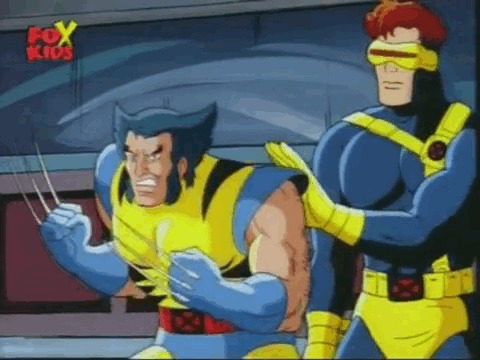
There, there.
3.) The Howling Commandoes Montage from Captain America – Before he was an Avenger, Captain America already knew how to be a team player. The Howling Commando unit was his first official team, and their theme music is heroic, percussive, and furtive, like most of their missions. It sounds like running, shooting, fighting, and classified ops. Alan Silvestri managed to capture some of the essence of the Captain America theme and yet make the Howling Commando theme unique to their team.
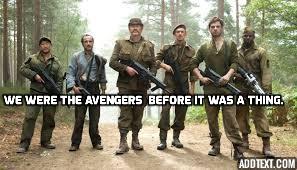
You never forget your first team.
4.) Fellowship Theme – Howard Shore’s Lord of the Rings soundtracks are a goldmine of themes used and re-used for the purposes of conveying a particular emotion or idea. The Shire theme often represents the Hobbits, Rohan’s theme evokes the tie of the people to the land through Theoden King and Eowyn, and the ethereal tones of Lothlorien often accompany Lady Galadriel and the elves. The Fellowship theme (properly called, “The Ring Goes South,” first emerges when the Fellowship becomes a team and steps out of Rivendell as a unit. The theme embodies their quest—epic, long, heroic, difficult, and dangerous.
As each member of the Fellowship steps out from between the rocks, it reads like an introduction. Here is our team, and we are about to get this show on the road. Have a look and a listen to this track, and see if you agree!
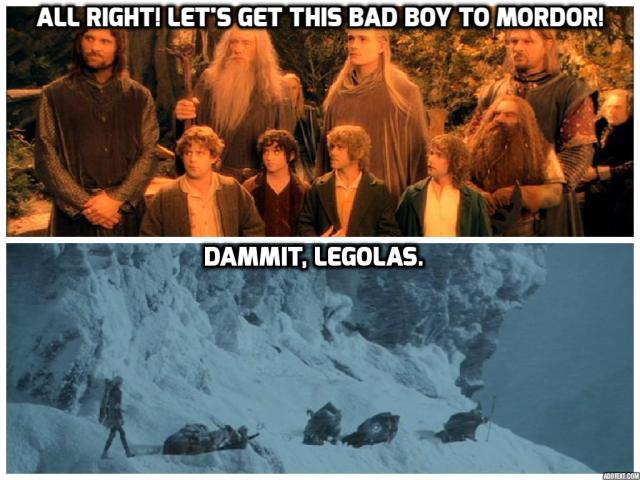
Why no one likes to travel with elves.
5.) Magnificent Seven(the TV show) – The Magnificent Seven TV show only ran for two seasons, but for a show with such a short run, it has a fairly massive online fandom. The whole concept of the Magnificent Seven, movies and TV show alike, are borrowed from Akira Kurosawa’s The Seven Samurai. I first came to appreciate Elmer Bernstein’s theme through the television series and not the movie. The characters were so diverse, so different from each other, and yet they were unified as a team.
Apart from the opening theme to the show, the first time the main theme is used is at the end of the pilot episode when the Magnificent Seven ride out together from their first successful mission in a line. The theme unifies a defrocked priest, a former slave, a Southern gambler, an innocent man with a bounty on his head, a cheerful womanizer, a kid, and their leader, the grumpiest Man In Black in the West. It’s a theme that focuses on the things they have in common rather than the many differences that sometimes cause dissent within the team.
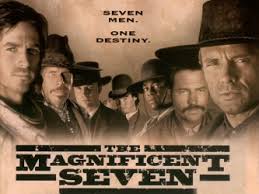
Together we stand. Divided we fall.
Place/Era:
1.) The Rocketeer – James Horner’s Rocketeer theme has a classic, sweeping tune that, like Captain America’s theme, recalls a “simpler time.” The movie is set near the same time period as Captain America, and both feature handsome men who spend a disproportionate amount of time hurtling through the air in specialized suits. The most heroic part of the theme can be found at the 2:00 mark. I have classified the Rocketeer’s theme as being more symbolic of an era than of an individual because even though the melody plays when Cliff flies as the Rocketeer, it is also used to set the atmosphere of the time period.
Elements of Horner’s theme are reminiscent of classical composer Aaron Copland’s 1942 Fanfare for the Common Man, and I feel like there are elements of Copland’s composition present in Captain America’s theme as well. Here, listen and tell me what you think in the comments! The Rocketeer is set in 1938, before the U.S. joined in World War II. Copland composed Fanfare for the Common Man in 1942, and Captain America: The First Avenger was set in 1943.
And the connections just keep on coming—Copland wrote the fanfare to mark the entry of the U.S. into World War II. Although it was suggested that he title it something like Fanfare for Soldiers, Copland chose instead to title it in the way that he did. Fanfare for the Common Man. Common men like Cliff, Steve, Bucky, and others who did great deeds. The musical cues are there, if you have the time to listen.
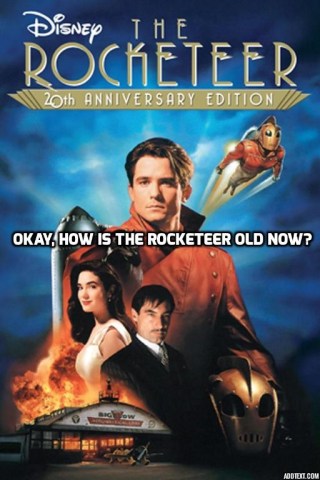
So. Old.
2.) Legend of Zelda – From Old Nintendo to present day, the Legend of Zelda main theme is synonymous with Hyrule, the land in which it takes place. The theme is not Link’s or Zelda’s—it belongs to the land. Whether it is the old, beepy version, or an orchestral presentation, hearing that theme invokes a sense of adventure, exploration, and a cautionary invocation from a random old man in a cave that it is dangerous to go alone.
As a kid, I had the privilege of watching my dad play a LOT of old Nintendo Zelda. He even had a binder of graph paper (he’s a math teacher) on which my brother and I mapped the game as he played. It was kind of genius, really. He would ask, “Who wants to map Zelda for Dad?” and my brother and I would fight over who “got” to do it. That’s what kids are for, right? Mapping Zelda on graph paper for Dad? We made note of every secret passage way, burnable shrub, and bore witness to our father being the only person we’ve ever heard of to beat Ganon (whose momma actually named him Ganondorf—that’s right. Ganondorf.) without ever finding the Magic Sword.
My dad beat The Legend of Zelda with the White Sword. I’m still proud, and I still remember watching him dodge and strike. That’s how I learned to nerd, people. From the dad who beat Zelda with just the White Sword and the mom who may just remember some shred of detail about Harry Potter that J.K. Herself forgot. The Zelda theme not only calls to mind the heroic antics of Link, Zelda, and the cave-dwelling elders of Hyrule, but also the triumphant moment when freaking Ganondorf went down, felled by the White Sword.
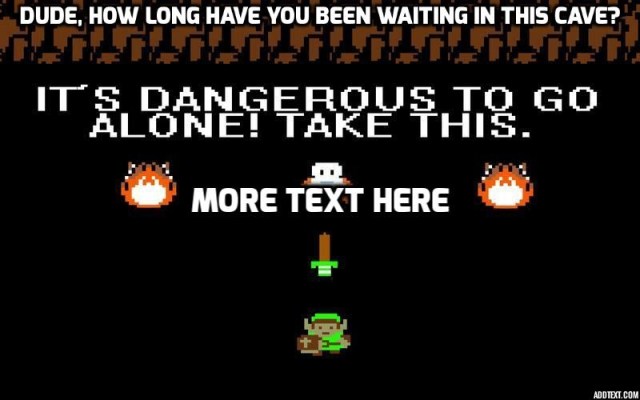
Oh, Hyrule. Always with the caves.
3.) The Neverending Story – The actual track title is “Bastian’s Happy Flight,” but the theme doesn’t really belong to Bastian or Atreyu or any one character. The theme is Fantasia’s and is symbolic of the fantastical nature of the place. Atreyu does the heavy lifting, heroically speaking, but Bastian has been with him through his reading of the book throughout. Composer Klaus Doldinger’s upbeat theme suggests flying, Falcor, and Fantasia’s triumph over The Nothing. Whatever you do, do NOT think about the Swamps of Sadness and Atreyu screaming at Artax to not sink into the Mud of Despair. Think of flying and Luck Dragons. For the love of God, think of the Luck Dragons! Seriously. WHY AM I CRYING??
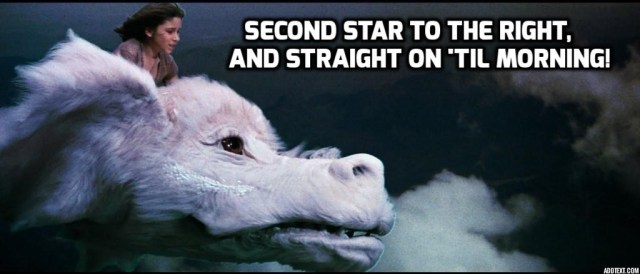
How do I get to Fantasia?
Sometimes, awesome music just defies categorization. Or, I’m just not a hundred percent sure with which category it would best align. I’m going to refer to these as belonging to the category of “honorable mention.” The Star Wars franchise was where my love of soundtracks and themes was born. It is full of heroic themes, from the Main Fanfare commonly associated with Luke to Duel of the Fates, arguably one of the only good things to come out of The Phantom Menace. The Main Fanfare doesn’t really belong to just Luke—it encompasses Leia, Han, Chewie, the Falcon, the spirit of adventure, and even mirrors my own enthusiasm as I watch. I feel like that had to be intentional. I’d love to know if part of what John Williams was thinking about when he created the theme was creating an association between the viewer and the film that would really stick. I know I get little shivers when I hear it in a theater.
Duel of the Fates is just as good. I didn’t get on the Phantom Menace hatewagon like many fans—I feel like it could have been better, but … I liked Young Obi Wan and Qui Gon Jinn waaay more than I disliked Kid Vader and the Gungan Sound Machine. I didn’t even really dislike them all that much. I just kind of wished those parts were done differently. No other piece of music is so incredibly suited to lightsaber battle as Duel of the Fates, and if you doubt me, you need to watch this video by The Piano Guys. It may be a parody video, but for the discerning ear, it can serve as a primer in soundtrack/theme complexity. The cellist in the video shows us how Duel of the Fates, the Main Fanfare, The Imperial March, and other pieces of the soundtrack as well all fit together. And, you get to watch cellists having a lightsaber duel with their bows. This feeds every part of my psyche that matters. I pretty much had an out-loud squee-fest upon contact. Ahem. My dignity. There it is, on the floor, looking all wrinkled up and kinda stepped on … oh, well. Who needs it anyway?
The Pacific Rim score by Ramin Djawadi fuses metal (the music) with metal (the metal the actual suits are made of) in a marriage of futuristic robots and classic screen tropes. The heroic, badass Main Title reflects the nature of the movie—metal robots fighting classic film Godzilla-style monsters and the instrumentation is a metaphor for this concept. The wailing “metal” guitars represent the suits, while the driving orchestrals embrace the flesh-and-blood creatures and the humans inside the machines. In a similar vein, Steve Jablonsky’s Transformers soundtrack is another favorite.
Whether you hated the film (OMG! My childhood is ruined!) or loved it (OMG! Optimus Prime’s voice is TALKING TO ME AGAIN FOR REALS!), the music is still epic and heroic, and manages to convey some very important things associated with the Transformers: The grave heroism of Optimus Prime, the otherness of our world to the Transformers, and the (literal, pun intended, driving determination they have to save the world. Believe me when I say that I was in the “OMG Optimus Prime!” camp. Say what you will about Michael Bay, but sometimes, a lady would like to see epic robot fights and massive explosions and not have to feel guilty about it. I haven’t seen the third one, but the first one gave me insane levels of feels, and the music, to quote one of my favorite humans, “makes my heart grow.” The track, “Arrival to Earth,” is beautiful, and contains the Optimus Prime theme, my personal favorite heroic theme from the movie. The track “No Sacrifice, No Victory” best illustrates one of my favorite aspects of this soundtrack and theme.
The overarching Optimus Prime and All Spark themes are slow, but forceful; however, behind the graceful notes of the themes, the percussion and strings are always moving, always quick. This is the true genius of the soundtrack for me. Optimus Prime is huge. He transforms into a big semi-truck. But … what are trucks and cars made of? Moving parts. Lots and lots of bits and pieces that make up the engine, wheels, pistons, etc. All working together to make a whole. The soundtrack is a beautiful, emotional metaphor for vehicles. It’s genius, and I’m still not over it. There is no better music for driving than the Transformers soundtrack, if you’re a movie score fan. It gives me this weird sense of purpose, like I have Things To Do and Places To Go.
The combination of choral and orchestral with the modern guitars and percussion evident in the Transformers and Pacific Rim music is also represented in Nobuo Uematsu’s “End of an Era” track from Final Fantasy XIV: A Realm Reborn. The track starts off with a wistfully heroic male chorus that is seriously reminiscent of the pre-heroic determination of “Misty Mountains Cold” sung by the dwarven party in The Hobbit. The track then moves into a solo female voice backed by acoustic guitar near the 1:00 mark. Then, things switch gears again at the 2:36 mark into a massively choral chant with male and female voices. Just when it seems like further crescendo might not even be possible, the electric guitars and percussion kick in, and the soloist’s voice changes from a gentle pop/light opera sound into a soaring, rockstar belt. Susan Calloway, it seems, is a damn good singer.
If you enjoy soundtracks and want to begin exploring video games as sources of new music, Nobuo Uematsu’s Final Fantasy scores are one of the best places I can think of to start. In 2012, I attended Matsuricon, an anime convention held in Columbus, Ohio, and Nobuo Uematsu was one of the guests. His panel was possibly one of the best I’ve ever attended. He really wanted to know what tracks of his people liked and why, and seemed genuinely happy to explain his own favorites. I didn’t bring anything cool to have autographed, so he signed my convention badge. I carry it around with me in my convention bag. Good Lord. I’m such a fangirl. ;-)
What are your favorite heroic themes? Why do you love them? If you want to discuss soundtracks and heroic themes further, please leave a comment or Tweet for us!
Sara Goodwin has a B.A. in Classical Civilization and an M.A. in Library Science from Indiana University. Once she went on an archaeological dig and found awesome ancient stuff. Sara enjoys a smorgasbord of pan-nerd entertainment such as Renaissance faires, anime conventions, steampunk, and science fiction and fantasy conventions. In her free time, she writes things like fairy tale haiku, fantasy novels, and terrible poetry about being stalked by one-eyed opossums. In her other spare time, she sells nerdware as With a Grain of Salt Designs, Tweets, and Tumbls.
—Please make note of The Mary Sue’s general comment policy.—
Do you follow The Mary Sue on Twitter, Facebook, Tumblr, Pinterest, & Google +?



